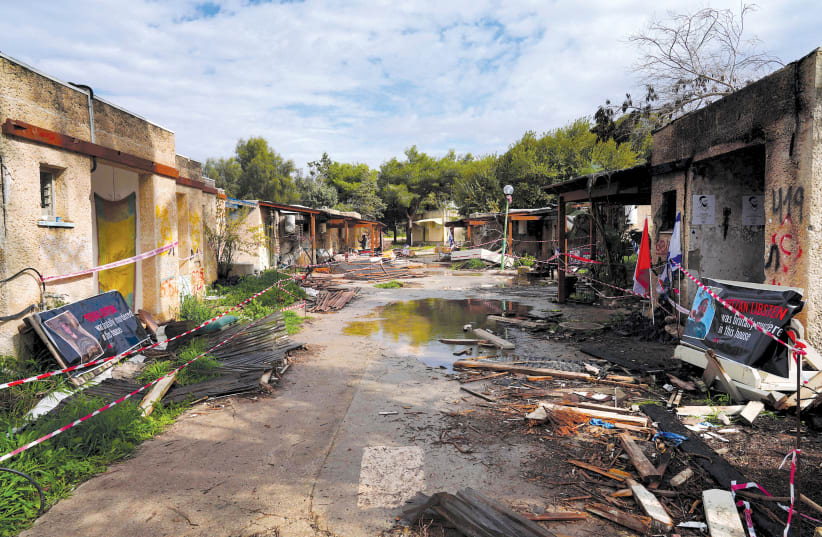ARTICLE AD BOX
The project aims to "make sure broad Latino non-Jewish audiences understand that Latinos were also impacted by Hamas' massacre."
By EVE YOUNG FEBRUARY 5, 2025 16:15 Updated: FEBRUARY 5, 2025 16:19 A view of houses in Kibbutz Kfar Aza four months after the October 7 massacre.
(photo credit: ALEXANDRE MENEGHINI/REUTERS)
A view of houses in Kibbutz Kfar Aza four months after the October 7 massacre.
(photo credit: ALEXANDRE MENEGHINI/REUTERS)
"'I'm burning. I can't breathe. I can't,' and then communication was cut off..." Esther recounted in the opening words of testimony in a new docuseries on the impact of the atrocities of October 7 on Latin American communities in Israel's South.
She was describing a call between her sister, slain in Hamas' October 7 onslaught on her southern community, and her sister's son.
Esther was a resident of Ein Hashlosha - one of the kibbutzim in Israel's south, and survived the attack. As of the time of filming, she had not yet moved back to her Kibbutz and is not sure she ever will.
"My sister's body was found 15 days later," she continued, explaining that this was "because they couldn't touch the walls for two days due to how hot they were."
Eventually, "they managed to get her body out by breaking the shelter's window. She was charred. She was burned."
The docuseries, "Testigos Del Terror," is in Spanish with English subtitles and highlights the stories of the Latin American victims of the Hamas attack, aiming to make as many Spanish-speakers both Jewish and non-Jewish aware of the atrocities of that day.
Fuente Latina
The series is a project of the organization Fuente Latina, which is working to break down "geographical, cultural and linguistic barriers for Spanish speaking media covering Israel, the Jewish world and the Middle East," and includes never-before-heard testimonies.
It includes, among many others, an interview with the grandmother of Ariel and David Cunio - both taken hostage and still held captive by Hamas - in which she describes her own October 7 encounters with terrorists.
One of the terrorists asked her where her family was from, and to explain to him, she said she was from the same place as world-famous footballer Lionel Messi.
She thinks that this distraction and human connection over Messi are part of what helped her survive that day.
Stay updated with the latest news!
Subscribe to The Jerusalem Post Newsletter
"Now I would ask him for my two grandchildren - who are captive there [in Gaza]," she added.
More than 100 Latin American immigrants were among the victims of the attack, according to the docuseries, which also highlighted some of the many victims with Latin American roots and family connections.
Eugenia, one of the survivors of the attack and a new immigrant, described in the video that she did not understand the word "machblim" when she was notified that they had entered her kibbutz. When she checked Google Translate and realized that it meant "terrorists," a feeling of terror overcame her.
Another episode of the docuseries focuses on the Nova music festival and includes footage filmed by a man who drove down to the festival to save the mother of his son, who was caught in the attack.
He described the harrowing things he saw on his drive to save her. "women were hung from trees; you can tell that people were tortured and burned," he said.
The mother of his child, who he was rushing to save, also spoke as part of the documentary, describing hiding in the desert for hours.
"I am not one to pray, but on that day, I asked god to not let this happen to me," she said.
While she was afraid of being killed, she was also terrified that she might be raped, she said, adding that she covered herself in mud to make herself disgusting to the terrorists.
A Spanish-speaking medical examiner also testified as part of the docuseries, describing horrific signs of torture on the bodies of those killed in the attack. From the soot in their throats, it was possible to deduce that some had been burned alive, he explained.
No one could have been prepared for the medical examinations of a massacre, he said, touching on the emotional impacts on him.
"There was a party for peace, and that party became a manhunt."
The first screening of the docuseries will take place on February 20 in Los Angeles. The goal is wide distribution, so creators are in talks with distributors, Fuente Latina founder and CEO Leah Soibel said.
Fuente Latina "was founded to tell these types of stories," Soibel explained, adding that the stories of Latin Americans in Israel have been a major point for connecting to non-Jewish Latinos in the US.
Now is the time to tell these stories and make these connections, she said, highlighting the debate around immigration and the significance of Latino voters in the US.
The project aims to "make sure broad Latino non-Jewish audiences understand that Hamas' massacre also impacted Latinos."
Many don't know that the family of hostage Shiri Bibas, who is held with her two infant sons Ariel and Kfir, has Latin American roots, she offered as example.
Polls show that Latin Americans harbor less antisemitism than many other population groups, she said, stressing that this could make them "key allies."
The project is also about documenting the stories of those who experienced October 7, she added.
"We felt we had to do justice to these stories and not just tell them in a soundbite form," she said, adding that the series is telling a side of Israel that very few Jews and non-Jews know."

 2 hours ago
3
2 hours ago
3








 English (US) ·
English (US) ·